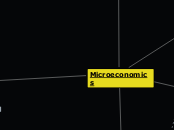Microeconomics
Utility Theory
Applications of Utility Theoruy
Consumer Surplus
Difference between the price that consumers are willing to pay for a product and what they actually pay
Adam Smith's paradox
Known as paradox of value
States/Explains that the goods critical for survival are cheaper than the goods that have no bearing on human existence
Example: Water is critical to survvival however is much cheaper than diamonds which are a luxury and not needed to survive
The Demand Curve
Marginal utility theory supports this idea
Theory states that as people receive less satisfaction while consuming more of a product, they will want to pay less for the product (the more you buy, the less you want to pay)
Theory states that as people consume more, the extra satisfaction they receive declines
Marginal Utility Theory of consumer choice
Consumer equilibrium
State of balance achieved by an end user of products
Refers to the amount of goods and services they can purchase given their present level of income and current level of prices
Utility Maximization Formula
Helps calculate which combination of products could give a consumer the most satisfaction
Marginal Utility = Marginal Utility
Price of product A Price of Product B
Util: Numerical values, or units of satisfaction
Utility: the ecoomic term for "satisfaction" or "usefulness"
Known as utility theory for short
Created by Alfred Marshall, also known as "the father of supply and demand"
Elasticity
Elasticity of Supply
There are 3 factors that affect supply elasticity
Cost Factors
Increasing output (supply) may be costly depending on the industry
Ease of Storage
Sellers have two options when the price of a product drops
Keep aside some inventory into storage, and sell it when prices rise again
Sell the product at a new and lower price
Time
The longer the time period a seller has to increase production, the more elastic the supply will be
Measures how responsive the quantity supplied by a seller is to a rise or fall in price
Coefficient of supply elasticity=
% change in quantity supplied
% Change in price
The responsiveness of quanities demanded and supplied to changes in price
Elasticity Of Demand
There are 4 main factors that may affect demand elasticity:
Amount of time available
Some goods may become elastic as consumers start to find substitutes for them
Fraction of Income spent on the item
Goods that are expensive and take up a large amount of a family budget are elastic
Nature of the Item
Goods that are neccessities tend to be more inelastic than goods that are considered luxuries/a want
Availability of substitues
Goods who have substitutes tend to be more elastic than goods that do not
Important for business people to know whether total revenues will rise or fall
Unitary Coefficient: A coefficient for a product that is equal to one
Given per cent change in price causes an equal per cent change in quantity demanded
Elastic Coefficient: Any coefficient for a product that is greater than one
These goods tend to be wants
Given per cent change in price causes a greater per cent change in quantity demanded
Inelastic Coefficient: Any coefficient for a product between zero and one
Givern per cent change in price causes a smaller per cent change in quantity demanded
These goods are tended to be neccessities
Price elasticity of demand
Formula to measure the actual change in quantity demanded for a product whose price has changed
Coefficient of demand elasticity=
% Change in quantity demanded
% Change in price
Government Intervention
Subsidies and Quotas
Quotas: Restriction placed on the amount of product that individual producers are allowed to produce
Marketing Boards
Composed of representaties from the government and from the producers
Organization who administer these quota restrictions
Subsidy: A grant of money made to a particular industry by rhe government
Subsidies also have some drawbacks:
Subsidies are seen as a barrier in free trade in the global economy
Subsidies may keep inefficient producers in business
Taxpayers pay for the progran
Subsidies have some advantages:
Has the advantage of Benefitting buyers with lower prices and sellers with extra revenue
Allows more of a product to be exchanged between buyers and sellers
Floor Prices: A government restriction that prevents a price from falling below a certain level
Example: Minimum wage
Maintaing these floor prices can cause two problems:
Second problem; Consumers pay a higher price but receive less
First problem is; what to do with the surplus
Sometimes, Surplus can be sold on the world market or distributed to less developed cpountries
Surplus is usually bought by government to ensure floor prices are kept
Floor price set above equilibrium creates surplus
Ceiling Prices: Restriction placed by a government in order to prevent the price of a product from rising above a certain level
Example: Rent Control
3 possible outcomes may occur with ceiling prices
Can cause quality of products to suffer/cevrease
Suppliers would want to lower down their productio costs, hence, they would try to find ways ot save their costs and could use cheaper materail for products meaning product quality would suffer
May create an "underground economy"
Occurs when a shortage of a product would cause certain consumers to buy a big stock of the product so that they could later sell it to people for a higher price.
Shortages may cause long line ups for the product
Example: When/if a government were to have ceiling prices on gasoline, it would cause gasoline shortages and long line ups. This would continue to occur until prices were allowed to be lifted once again causing supply and demand to remerge at the equibilarium
Supply
Supply for products depend on certain factors:
Prices of related goods
Refers to substitute goods. If prices of substitue goods is lower, consumers would want more of those increasings its demand, eventually increasing supply.
Government Policies
Different government policies such as fiscal policies would have a great impact on the supply of products
Example: Increasing taxes would decrease supply
Price
The price of a product and the supply of the product are directly related (direct relationship). If prices of a product increases, so does its supply.
Cost Of Production
An increase in production costs would decrease the quantity supplied as owners do not want to have high production costs
Example: Suppliers would decrease supply for a product when they realize production costs are exceeding the market price of the product
Law of Supply: The quantity supplied will increase if price increases and fall if price falls, as long as other things do not change
Quantities sellers will offer for sale at various prices during a given period of time
Supply Schedule: A table representing the relationship between the price of a good and the quantity supplied
Demand
Changes In Demand May Occur due to different factors:
Prices of Substitute goods/complement goods
Decrease in the price of goods would increase demand as consumers could purchase more in less of an amount than usual
Increase in the price of goods would decrease demands as consumers wouldn't want to spend that much
Taste and Prefrences
Example: A celebrity endorsing a specific product such as an acne treatment could potentially change consumer preferences and help increase the demand for that product
Population:
Decrease in population would decrease demand on products and services as left people are present to purchase
Increased population would increase demand for products as more people are present to purchase
Income: A change in consumer income could affect demand for products and services
Law Of Demand: The quantity demanded varies inveserly with price, as long as other things do not change
Income Effect: Change in demand of a good or service due to a consumers discretionary income
Example: The money consumers would save from buying non branded pasta would represent the consumers extra income. Some consumers would use that extra income to purchase another box of the same pasta, thus, increasing its demand.
Substitution Effect: As the price of a particular good rises, consumers start to Substitute similar goods for it
Example: If the price of a well known branded pasta such as PRIMO were to rise, consumers would start to substitute and purchase a pasta that is a different brand such as compliments as it's price is lower and more affordable. This would decrease the demand of the branded pasta and increase demand for the no brand pasta.
The quantity of a good or service that buyers will purchase at various prices during a given period of time
Demand Curve: A graph illustrates how the demand for a commodity or service varies with its price (illustrates demand schedule)
Demand Schedule: Numeric illustration usually in a graph representing the quantities demanded at selected prices
Consumer Demand for products depends on certain factors:
Price of Product or Service
Moderate/Low prices keep demand stable and increases demand as consumers find the price within their budget and find spending affordable
High prices decreases consumer demand as consumers do not want to spend such a high amount
Financial Resources
Consumers must have enough income and financial stablity to freely be able to purchase the product/ service
High income increases demand
Low Income decreases demand
Desire
Consumers must desire the product in order for the products demand to be high









